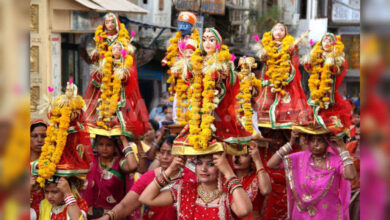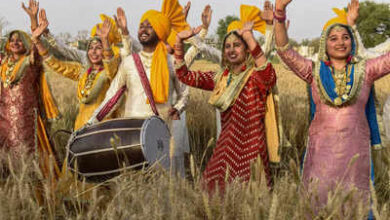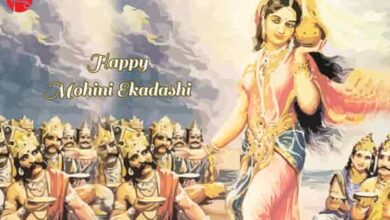Aoling Festival: Celebrating the New Year in India
Experience the vibrant and colorful Aoling Festival, a cultural celebration of the Konyak tribe in India. Join in the traditional dancing, feasting, and rituals as you immerse yourself in this unique and unforgettable event.
Quick Facts:
Date: First week of April
Main Components: Celebration of the new year in the Aoling Festival with traditional dances, music, and feasting.
Popularity: The Aoling Festival is a popular traditional festival celebrated by the Konyak Naga tribe in Nagaland, India.
Pairings: Aoling Festival is a traditional festival celebrated by the Konyak tribe in Nagaland, India, to mark the arrival of spring and the start of the new year.
Variations: Aoling Festival: a celebration of the Konyak Naga tribe in India, featuring traditional dances, songs, and rituals.
Introduction to Aoling Festival
The Aoling Festival is a traditional festival celebrated by the Konyak Naga tribe in the Mon district of Nagaland, India. It marks the beginning of the Konyak New Year and is a time for the community to come together and celebrate with music, dance, and feasting. The festival typically lasts for six days and includes various rituals and ceremonies, such as the cleansing of the village, traditional games, and the wearing of traditional attire. It is a vibrant and colorful festival that offers a unique insight into the rich cultural heritage of the Konyak Naga tribe.
The Aoling Festival is not only a time for the Konyak Naga tribe to celebrate their cultural traditions, but also a time for sharing their customs and practices with others. The festival attracts visitors from all over the world who come to witness the unique rituals and traditions of the Konyak Naga tribe. It provides an opportunity for cultural exchange and understanding, as well as a chance for the tribe to showcase their traditional music, dance, and craftsmanship. The Aoling Festival is a truly special event that highlights the cultural diversity and richness of the Konyak Naga tribe.
History and origins of Aoling Festival
The Aoling Festival is a traditional harvest festival celebrated by the Konyak Naga tribe in Nagaland, India. It is believed to have originated from the ancient animistic rituals and agricultural practices of the tribe. The festival marks the end of the old year and the beginning of the new year, and is a time for the community to come together to give thanks for a successful harvest and to pray for prosperity in the coming year.
The Aoling Festival is characterized by traditional dances, songs, and rituals that are performed to appease the spirits and seek their blessings for a bountiful year ahead. It is a time for the Konyak Naga people to showcase their rich cultural heritage and to strengthen the bonds of their community through shared traditions and celebrations.
Cultural significance of Aoling Festival
The Aoling Festival is a significant cultural event celebrated by the Konyak Naga tribe in Nagaland, India. It marks the arrival of spring and is a time for the community to come together and celebrate their cultural heritage. The festival includes traditional dances, music, and rituals that have been passed down through generations, making it an important event for preserving and promoting the tribe’s unique cultural identity.
The Aoling Festival also serves as a platform for the Konyak Naga tribe to showcase their traditional arts and crafts, such as handwoven textiles and intricate wood carvings. It is a time for the community to come together and share their customs and traditions with outsiders, helping to promote understanding and appreciation for the rich cultural heritage of the Konyak Naga people.
Traditions and customs of Aoling Festival
The Aoling Festival is a major agricultural festival celebrated by the Konyak tribe of Nagaland, India. The festival marks the end of the old year and the beginning of the new year, and is celebrated with great enthusiasm and fervor. The festival is characterized by traditional dances, music, feasting, and various rituals that are meant to bring good luck and prosperity to the community.
During the Aoling Festival, the Konyak tribe also practices various customs and traditions such as wearing traditional attire, performing indigenous games and sports, and participating in community feasts. The festival is a time for the Konyak people to come together, strengthen their cultural bonds, and seek blessings for a bountiful harvest and a prosperous year ahead.
Food and drinks associated with Aoling Festival
The Aoling Festival, celebrated by the Konyak Naga tribe in India, is known for its traditional food and drinks. During the festival, people indulge in a variety of dishes such as smoked pork, bamboo shoot curry, and rice beer. The rice beer, known as “thutse” or “Apum,” is an essential part of the celebration and is consumed in large quantities as a symbol of joy and unity among the community.
The food and drinks associated with the Aoling Festival hold great cultural significance for the Konyak Naga tribe. The traditional dishes and rice beer are not only enjoyed for their flavors, but also for the sense of community and tradition they bring to the festival. These culinary delights play a crucial role in preserving the cultural identity and heritage of the Konyak Naga tribe during the Aoling Festival.
Music and dance performances at Aoling Festival
The Aoling Festival is a cultural celebration in the Konyak tribe of Nagaland, India, featuring traditional music and dance performances. The festival is a time for the community to come together and showcase their rich cultural heritage through lively and colorful performances.
During the festival, visitors can experience the mesmerizing rhythms of traditional Konyak music and witness the graceful movements of the tribal dance forms. The performances at the Aoling Festival provide a unique opportunity to immerse oneself in the vibrant and dynamic cultural traditions of the Konyak people.
Aoling Festival attire and traditional clothing
The Aoling Festival is a major celebration for the Konyak tribe of Nagaland, India. During the festival, the Konyak people wear traditional attire that reflects their cultural identity. Men wear loincloths and headgear adorned with feathers and animal horns, while women wear intricately woven shawls and skirts. The vibrant colors and unique designs of their clothing showcase the rich heritage and traditions of the Konyak tribe.
The Aoling Festival attire holds great significance for the Konyak people, as it symbolizes their connection to their ancestors and the spirit of their community. The traditional clothing worn during the festival is passed down through generations, and each piece carries with it the stories and values of the Konyak tribe. Through their attire, the Konyak people pay homage to their cultural heritage and celebrate their identity as a distinct indigenous group.
Aoling Festival activities and events
The Aoling Festival, celebrated by the Konyak Naga tribe in India, is a grand festival filled with various activities and events. The festival includes traditional dances, music performances, and cultural displays. There are also sporting events, such as traditional Naga wrestling and archery competitions, as well as feasting and drinking of rice beer.
During the Aoling Festival, the Konyak Naga tribe also participates in traditional rituals and ceremonies, such as the blessing of the fields for a bountiful harvest and the reenactment of ancient warrior dances. The festival is a vibrant celebration of the tribe’s rich cultural heritage and a time for the community to come together and honor their traditions.
Aoling Festival in modern times
The Aoling Festival, also known as the Konyak New Year, is a major cultural event celebrated by the Konyak tribe in Nagaland, India. In modern times, the festival has evolved to include traditional song and dance performances, sports competitions, and feasting on local delicacies. It is also a time for the Konyak people to come together and showcase their rich cultural heritage to visitors from around the world.
The Aoling Festival has become an important platform for preserving and promoting the unique traditions and customs of the Konyak tribe. In addition to the traditional rituals and ceremonies, the festival now also includes contemporary elements such as fashion shows and music concerts, making it a vibrant and dynamic celebration of Konyak culture in the modern era.
How to participate in Aoling Festival
To participate in the Aoling Festival, one must first be invited by the Konyak tribe in Nagaland, India. The festival, which celebrates the arrival of spring, involves traditional dances, feasting, and various rituals. Visitors are encouraged to dress in traditional Konyak attire and participate in the festivities, which usually include hunting, wrestling, and other cultural activities. It’s a unique opportunity to immerse oneself in the rich traditions of the Konyak tribe and experience the vibrant culture of Nagaland.
In addition to participating in the cultural events, visitors can also sample the local cuisine and witness the craftsmanship of the Konyak people, known for their intricate wood carvings and hand-woven textiles. The Aoling Festival offers a chance to engage with an ancient and fascinating culture, and to gain a deeper understanding of the traditions and customs of the Konyak tribe.
Hidden Facts
1. The Aoling Festival is a traditional festival celebrated by the Konyak Naga tribe in Nagaland, India.
2. It marks the beginning of the Konyak Naga New Year and is celebrated with great enthusiasm and fervor.
3. The festival involves various rituals, feasting, singing, and dancing, as well as traditional games and sports.
4. One of the unique aspects of the Aoling Festival is the performance of the traditional war dance by the Konyak warriors.
5. The festival also includes the traditional ceremony of blessing the fields for a bountiful harvest in the coming year.
6. The Aoling Festival is a time for the Konyak Naga tribe to come together and celebrate their culture and traditions.
Top 10 Best Wishes For Aoling Festival
1. May the Aoling Festival bring joy and happiness to all! #AolingFestival #Celebration
2. Wishing everyone a colorful and vibrant Aoling Festival! #Traditions #Nagaland
3. May the Aoling Festival be filled with laughter and love for all who celebrate! #FestiveSpirit #Community
4. Wishing for a prosperous and bountiful Aoling Festival for everyone! #HarvestSeason #Abundance
5. May the Aoling Festival bring peace and unity to all who partake in the festivities! #CulturalHeritage #Unity
6. Wishing for a memorable and joyful Aoling Festival for all! #Memories #FestiveMoments
7. May the Aoling Festival be a time of togetherness and camaraderie for all! #FamilyTime #Friends
8. Wishing for a successful and fulfilling Aoling Festival for the communities celebrating! #Success #Fulfillment
9. May the Aoling Festival bring blessings and good fortune to everyone! #Blessings #GoodLuck
10. Wishing for a safe and enjoyable Aoling Festival for all who take part in the festivities! #SafetyFirst #Enjoyment
Top 10 Best Messages For Aoling Festival
1. Happy Aoling Festival to everyone celebrating the beautiful traditions and culture of the Ao Naga people! #AolingFestival #Nagaland
2. Wishing you all a joyous and colorful Aoling Festival filled with traditional dances, music, and feasting! #AolingFestival #AoNaga
3. May the spirit of the Aoling Festival bring peace, prosperity, and happiness to all who celebrate this special time. #AolingFestival #AoTribe
4. Let’s come together to honor the rich heritage and customs of the Ao Naga community during the Aoling Festival. #AolingFestival #NagalandPride
5. As we mark the Aoling Festival, let’s embrace the spirit of unity, love, and respect for all cultures and traditions. #AolingFestival #AoNagaCulture
6. Happy Aoling Festival to our Ao Naga friends and neighbors! May this festival bring abundant blessings and goodwill to all. #AolingFestival #NagalandTraditions
7. Let’s celebrate the Aoling Festival with joy and reverence for the traditions and values of the Ao Naga people. #AolingFestival #AoNagaPride
8. Wishing everyone a vibrant and festive Aoling Festival, filled with the beauty of Ao Naga culture and heritage. #AolingFestival #NagalandCelebration
9. May the Aoling Festival bring communities together in harmony and understanding, honoring the rich legacy of the Ao Naga people. #AolingFestival #AoNagaHeritage
10. Happy Aoling Festival! Let’s cherish and preserve the unique customs and rituals of the Ao Naga tribe for generations to come. #AolingFestival #NagalandTraditions
Top 10 Best Quotes For Aoling Festival
1. “The Aoling Festival is a celebration of the rich and vibrant culture of the Konyak tribe in Nagaland.”
2. “During the Aoling Festival, the Konyak people come together to honor their ancestors and seek blessings for the future.”
3. “The Aoling Festival is a time for feasting, dancing, and traditional rituals that have been passed down for generations.”
4. “The colorful and elaborate traditional attire worn during the Aoling Festival is a sight to behold.”
5. “The Aoling Festival is a reminder of the resilience and strength of the Konyak tribe in preserving their cultural heritage.”
6. “Participating in the Aoling Festival is a unique opportunity to experience the warmth and hospitality of the Konyak people.”
7. “The Aoling Festival is a time for reuniting with family and friends, and creating lasting memories.”
8. “The Aoling Festival is a symbol of unity and harmony within the Konyak community.”
9. “The Aoling Festival is a testament to the enduring traditions and customs of the Konyak tribe.”
10. “Attending the Aoling Festival is an immersive experience that offers a glimpse into the rich history and traditions of the Konyak people.”



